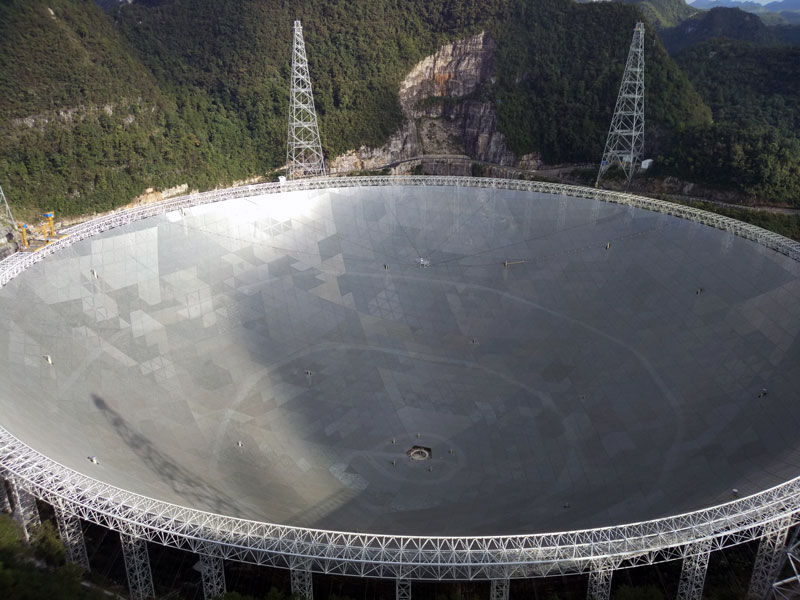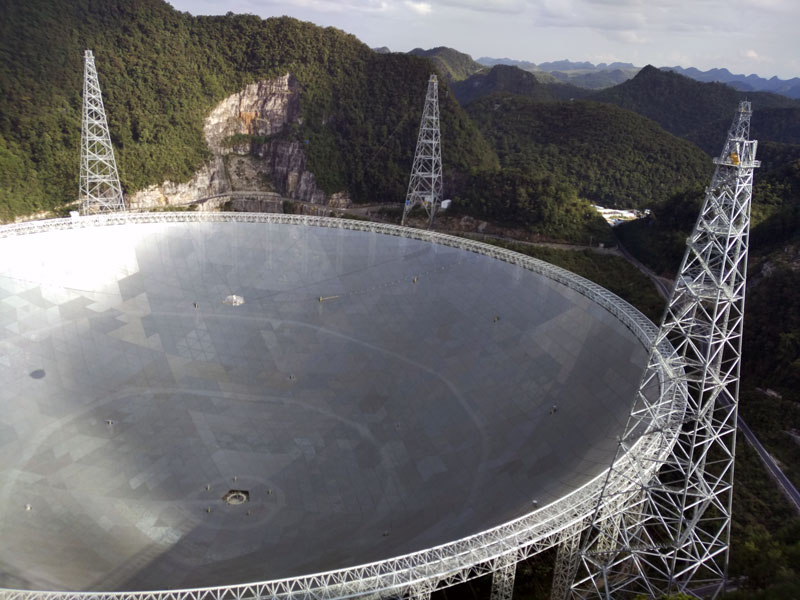At shortly before 10.30am on January 3, 2019, the China National Space Administration (CNSA) made history, landing the first-ever probe – Chang’e-4 – on the far side of the moon. The accomplishment drew international attention and highlighted China’s commitment to rival the United States and Russia in the field of space exploration.
Over 380,000 kilometers away from the plot of lunar land currently being explored by Chang’e-4, in a small rural county in China’s Guizhou province, another type of galactic exploration is currently underway using the world’s largest filled-aperture radio telescope. Dubbed the Five-hundred-meter Aperture Spherical Radio Telescope, but more commonly referred to as FAST, or by its Chinese nickname Tianyan (meaning ‘Sky Eye’), the observatory was completed in 2016 and is expected to begin normal operations this year. Since its completion, the observatory has been monitoring the heavens, observing pulsars and working to detect interstellar molecules, among other missions. Perhaps most interesting of all, the facility is expected to be a powerful tool in the search for extraterrestrial intelligence.
The hunt for advanced beings and civilizations on other worlds is not a new field of study. Up until the early 1990s the United States’ NASA ran a program dedicated to finding ET. What is new, however, is China’s elevated role in the search, which is in large part due to the country’s massive, unblinking ‘eye on the sky.’
Gazing Out
There is more to space exploration than rovers and rockets, and the hunt for intelligent life elsewhere in the universe is – at present, anyway – best served by neither. Instead, researchers involved in the search for extraterrestrial intelligence (SETI) utilize a number of Earth-based technologies to try to detect telltale signs that we are not alone in the universe.
These signs, simply put, are technology, or evidence of technology, that is not of earthly origin. This could include the discovery of space-based megastructures (Google ‘Dyson sphere’ for reference), artificial pollutants impacting on the light emitted from distant celestial bodies, the discovery of probes or other alien artifacts and laser or radio signals.
For nearly seven decades, radio signals have been the main focus of SETI researchers.
According to the SETI Institute, a nonprofit organization dedicated to the study of life in the universe, virtually all of the radio signals that SETI is currently looking for are ‘narrow-band signals,’ which are possibly “only a few hertz wide or less.” These, according to the institute’s website, are an indication of an intentionally constructed transmitter and are easily distinguishable from naturally occurring interstellar noisemakers such as pulsars (rapidly rotating neutron stars that emit consistent radio wave ‘pulses’).

FAST. Image via Jill Barron
Guizhou’s FAST is one such facility that may soon be, for lack of a better term, ‘listening’ for signals from the stars. The colossal, 500-meter-diameter radio telescope is situated in a natural depression surrounded by a cluster of karst peaks. From above, it looks like the world’s largest rice bowl (Fun fact: according to the Atlantic, the dish is large enough to hold two bowls of rice for every person on the planet).
The winding route from Guizhou province’s capital, Guiyang, to Pingtang county, where FAST is located, is a scenic one. During the nearly three-hour bus journey, I pass by towering, jagged karst mountains and clear, rushing rivers, as well as a few sparsely populated villages composed of simple, white buildings and overgrown ancestral shrines.
Pingtang’s far-flung location is fully brought into focus when I arrive at Kedu town’s dusty, one-room bus terminal, where I come to the startling realization that the town has no taxis and Didi is essentially nonexistent. Fortunately, after some haggling, I secured a ride to my accommodation from a friendly restaurant owner.
“The economy here is still very poor and business is not very good, except during the summer months when more people visit [FAST],” the restaurateur-turned-cabbie tells me, before adding that not many people in the town are employed at the Sky Eye.
Like several others I speak with, the driver, originally from Hubei, says that he moved to the region to open his business after construction on FAST began, hoping that the facility would provide a steady flow of visitors and income.

Pingtang International Experience Planetarium. Image by Matthew Bossons/That’s
When we pull up at my hotel, which is located a stone’s throw from the Pingtang International Experience Planetarium, it’s clear that early April is not a popular time for tourists, as both the hotel and planetarium are as devoid of life as the lunar surface.
In the planetarium’s case, this is for good reason: the educational facility is a major letdown for anyone who has ever visited a museum in China’s first-tier cities. Unrealistic displays and models – as well as low-quality TV monitors – plague the space, and the experience center’s two food vendors serve up gruel that can only be described as ‘food poisoning waiting to happen.’ Really, the only reason to visit the planetarium is to access the telescope itself.
I purchase a ticket to visit the telescope from the visitor’s center next to the planetarium, before depositing my mobile phone inside a locker (electronic devices are not allowed near FAST, lest their signals interfere with the Sky Eye’s delicate search). Next, before I can board a tourist bus bound for the monumentally large scientific instrument, security personnel wave me through a metal detector and conduct a bag scan to ensure that no electronics, cigarettes, lighters or other prohibited goods make it to the telescope’s rim.
A 20-minute bus ride and 800-stair climb later, I finally arrive at China’s ‘eye on the sky.’
ET Phones Earth
On August 15, 1977, a two- to two-and-a-half-minute signal from deep space was picked up by Ohio State University’s now-defunct ‘Big Ear’ radio telescope. The signal, which was hailed by NPR in 2010 as “one of the grandest riddles in modern science,” wasn’t formally discovered until three days later, when Professor Jerry Ehman was poring over the telescope’s printed records. When Ehman noticed the six-symbol sequence – 6EQUJ5 – on one of the printouts he was examining, he circled it in red marker and wrote “Wow!” beside it. Henceforth, this narrow-band radio signal, which was traced to the constellation Sagittarius, has been appropriately referred to as the ‘Wow! Signal.’
The signal is extraordinary for a couple of reasons: 1) at its loudest point it was over 30 times louder than normal noise observed in deep space, and 2) it falls in the frequency range that scientists have predicted that other intelligent beings will try to communicate in. Unfortunately for researchers though, the Wow! Signal has never been detected again, despite subsequent searches.
Ehman’s exciting 1977 discovery isn’t the only eyebrow-raising signal from space that has been detected in recent history. Berkley SETI Research Institute’s Search for Extraterrestrial Radio Emissions from Nearby Developed Intelligent Population (SERENDIP) program has allegedly picked up close to 400 suspicious signals. As of now, there is insufficient data to prove any of them came from extraterrestrial life. While researching for this story, I found no evidence to indicate that China has previously received signals of interest to folks involved in SETI. That, however, may soon change.

Alien display at Pingtang International Experience Planetarium. Image by Matthew Bossons/That’s
Since its completion, FAST is now one of mankind’s greatest SETI tools and there is a good chance the next headline-grabbing signal may be detected in Guizhou.
It was back in October of 2016 that FAST officially – on paper, anyway – joined the hunt for scientific evidence of life beyond Earth at a ceremony held in Beijing. The announcement came in a joint statement from the National Astronomical Observatories of China (NAOC) and the Breakthrough Initiatives, a 10-year SETI program founded in 2015.
“‘Are we alone?’ is a question that unites us as a planet,” said Yuri Milner, founder of the Breakthrough Initiatives, in a press release issued at the time. “And the quest to answer it should take place at a planetary level too. With this agreement, we are now searching for cosmic companions with three of the world’s biggest telescopes across three continents.”
In addition to FAST, the Green Bank Telescope in the US and the Parkes Observatory in Australia are also participating in the Breakthrough program.
“[FAST] is the world’s largest filled-aperture radio receiver, and will be one of the most powerful instruments to search for potential intelligent life beyond Earth,” said Professor and Director General Jun Yan of the NAOC at the Beijing media briefing. “We are delighted to be collaborating with the Breakthrough Initiatives.”
In a 2017 article from the Atlantic, Director Andrew Siemion from the Berkley SETI Research Center was enthusiastic about Guizhou’s massive space-observing dish, telling Senior Editor Ross Andersen that FAST is our planet’s most sensitive telescope that’s focused on the part of the radio spectrum “classically considered to be the most probable place for an extraterrestrial transmitter.”
This is, after all, part of the reason the observatory was constructed in the first place. Chinese astronomer Nan Rendong, the founder, chief scientist and chief engineer of FAST up until his death in 2017, personally ensured that the dish was tailor-made to participate in the search for messages from distant worlds. According to Andersen’s Atlantic piece, Nan was a participant in the FAST project from its initiation in the early 1990s when he helped select the site to build the observatory.

Intergalactic wall art near Pingtang International Experience Planetarium. Image by Matthew Bossons/That’s
In addition to the observatory’s prime location, there is another factor that makes it a candidate to detect an alien signal: how much sky it can observe, or, its field of view.
“It depends in which frequencies extraterrestrials are broadcasting,” Professor Denis Bastieri, a special advisor in Guangdong from the department of physics and astronomy at the University of Padova, tells me. “The Arecibo Observatory [in Puerto Rico] is better at detecting higher frequencies compared to FAST, but as we don’t know where extraterrestrials are, it is of paramount importance to have a large field of view, which favors FAST.”
Admittedly, there is no official confirmation that FAST is currently listening for alien signals, or will begin doing so in the near future. While numerous sources I accessed and have cited throughout this piece lead me to believe China is currently – or soon will be – an active participant in SETI programs, a Global Times story published late last year refutes that FAST is presently looking for life beyond Earth. The story was in response to media reports that FAST would begin hunting for aliens in 2019, once its trial period is complete and normal operations begin.
The Global Times article fails to state when the observatory will begin hunting for signs of life beyond Earth, but does note that the telescope “is totally qualified for such a task.”
Now that China is equipped with one of the world’s best SETI tools, the question becomes: is there anybody out there, and are they trying to reach us?
Radio Silence
In 1961, astronomer and astrophysicist Dr. Frank Drake devised his namesake probability theory, the ‘Drake Equation,’ an approach to measure the number of technologically advanced civilizations within our home galaxy, the Milky Way. While much of the celebrated theory, which looks at things like the number of habitable planets around stars in the Milky Way and how long a civilization might be detectable for, is highly speculative, it has resulted in a range of estimates on how many intelligent, off-Earth societies may exist in our cosmic neighborhood.
Italian astronomer and mathematician Claudio Maccone, according to Astrobiology Magazine, has speculated that our galaxy may be home to as many as 4,590 advanced alien communities. Other estimates range greatly, from 1,000 civilizations to as many as 50 or even 100 million.
But if so many intelligent, tech-savvy beings exist in the Milky Way, then, to quote physicist Enrico Fermi, “Where is everybody?” This is the essence of the Fermi Paradox, the ostensible contradiction between the high estimates often produced by the Drake Equation and the stunning lack of evidence available that we aren’t our galaxy’s lone inhabitants.

Image via Pixabay
There are so many plausible explanations to the Fermi Paradox that you could literally assemble a 2-inch-thick textbook trying to catalogue them all. Aside from the obvious theory (we are alone), it could also be that it’s the nature of intelligent life to eventually destroy itself (through war or environmental devastation, to name just two), or that we’re simply too far apart in time and space to establish communication with our cosmic brothers and sisters. Others suggest human civilization has not been around long enough to detect messages, or that intelligent life only broadcasts detectable radio signals for fleeting periods of time.
There are other more sinister theories, one of which is explored in Chinese science fiction author Liu Cixin’s Remembrance of Earth’s Past trilogy: that intelligent life in the universe might avoid making itself noticed out of fear they may attract the attention of hostile creatures. In 2017, the Atlantic’s Andersen spoke with Liu, whose novella The Wandering Earth was recently adapted into one of China’s highest-grossing films ever, and wrote at length about his Dark-Forest Theory, the idea that any and all of the universe’s hypothetical civilizations might be a “hunter hiding in a moonless woodland, listening for the first rustlings of a rival.” (Versions of this theory pre-date Liu’s series, but the term ‘Dark-Forest Theory’ can be traced back to the Remembrance of Earth’s Past trilogy.)

Liu Cixin. Image via Wikimedia
The Dark-Forest Theory suggests it might be inherently dangerous to try to establish contact with other galactic populations, and draws on earthly examples, such as the arrival of Europeans in the New World and Asia, to illustrate the potential risk of colonization and, possibly, destruction.
But even if alien life might avoid contact, we could assume that radio pollution from their daily existence might be detectable with earthly tools such as FAST. After all, human beings have been spewing radio signals into space since before the Second World War, so who’s to say that aliens haven’t been doing the same for far greater periods of time?
Those stray signals, though, might be too weak to pick up, according to Professor Li Ran at the NAOC.
“Another planet trying to detect a signal from Earth, even though we have a lot of radio signals being broadcast by radio channels, would have a hard time because these signals are still very weak,” Li tells That’s writer Naomi Lounsbury. “Unless we are trying to broadcast towards them on purpose to establish contact, it’s very hard to be heard.”
But this is all merely hypothetical. And who knows, first contact could, in theory, come as soon as tomorrow.
First Contact?
Sitting atop the tourist observation platform that’s positioned along the rim of the massive, bowl-shaped telescope, it’s easy to get lost in the beauty of the surrounding scenery. The rocky mountains and lush, semi-tropical vegetation that surround the dish offer a pleasant contrast to the metallic sheen of the telescope, and, more practically, help to block out interference from wind and Earth-based radio noise.
I spend a little over an hour at FAST, and, when the weather looks set to turn on me, I begin the arduous hike down the backside of telescope’s surrounding peaks to the observatory’s parking lot.

FAST. Image via Jill Barron
Later, back in town, I pose a question to an 11-year-old girl operating a small cold noodle stall across the road from Pingtang International Experience Planetarium: “What do you think an alien message would state, or ask?”
“I think they’d say hello, and ask us our names,” the girl retorts. It’s difficult to say what information an intergalactic signal may include, but I reckon the youngster’s guess is as good as any.
Two questions remain, though: Would we even be able to understand an alien signal? And, if China makes ‘first contact,’ how would the country respond?
On the SETI Institute’s FAQ page, our first question receives a simple and honest answer: “No one knows.”
“It’s conceivable that an advanced and altruistic civilization will send us simple pictures and other information. They might do this because they are hundreds (or more) of light-years [away from us]. That would make real back-and-forth communication tedious at best,” reads the SETI Institute’s website. “So, these alien broadcasters might be tempted to send lots of information, and in a format that we could eventually decipher. Then again, we might pick up a signal that was never intended for us, in which case, it might be impossible to figure it out.”

Voyager Golden Record. Image via Wikimedia
Mankind has previously sent messages out into the abyss of space, and the people behind those communication attempts had to grapple with same issue: creating a message that could be understood by beings that lack earthly context. Famed American astronomer Carl Sagan reportedly spent a year curating the content for the Voyager Golden Record, a message to extraterrestrial intelligence that is currently hurtling through interstellar space aboard the Voyager 1 space probe – the furthest known man-made object from Earth. If we do receive a deliberate signal from space, fingers crossed that the senders took the same care in preparing its content as Mr. Sagan did.
China’s response to such a message is also uncertain. According to the SETI Institute, any confirmation of extraterrestrial intelligence “should be disseminated promptly, openly and widely through scientific channels and public media, observing the procedures in this declaration. The discoverer should have the privilege of making the first public announcement.” In addition to a number of other non-binding provisions, the institute’s website notes that no response should be issued until “appropriate international consultations have taken place.”
When confronted with the question of China’s response to such a groundbreaking discovery, Li says that extensive confirmation work would first need to be done to ensure the signal was authentic and not a naturally-occurring noise from space.
“Before submitting any report to the government or media, scientists would first try to make sure [the signal] is not coming from earth. This is step one,” says Li. “Step two would be trying to figure out what information [a message] really contains.” He adds that once the message is confirmed by the scientific community, it will be “up to other people” to decide how to proceed.
And proceed they will, one day, if a mysterious signal from space ever arrives in the remote part of China that is Pingtang county.
This feature is our May 2019 cover story for That's Shanghai, That's Beijing and That's PRD. Check out the full issues online here.
[Cover image via Hubble Space Telescope/NASA]






















0 User Comments